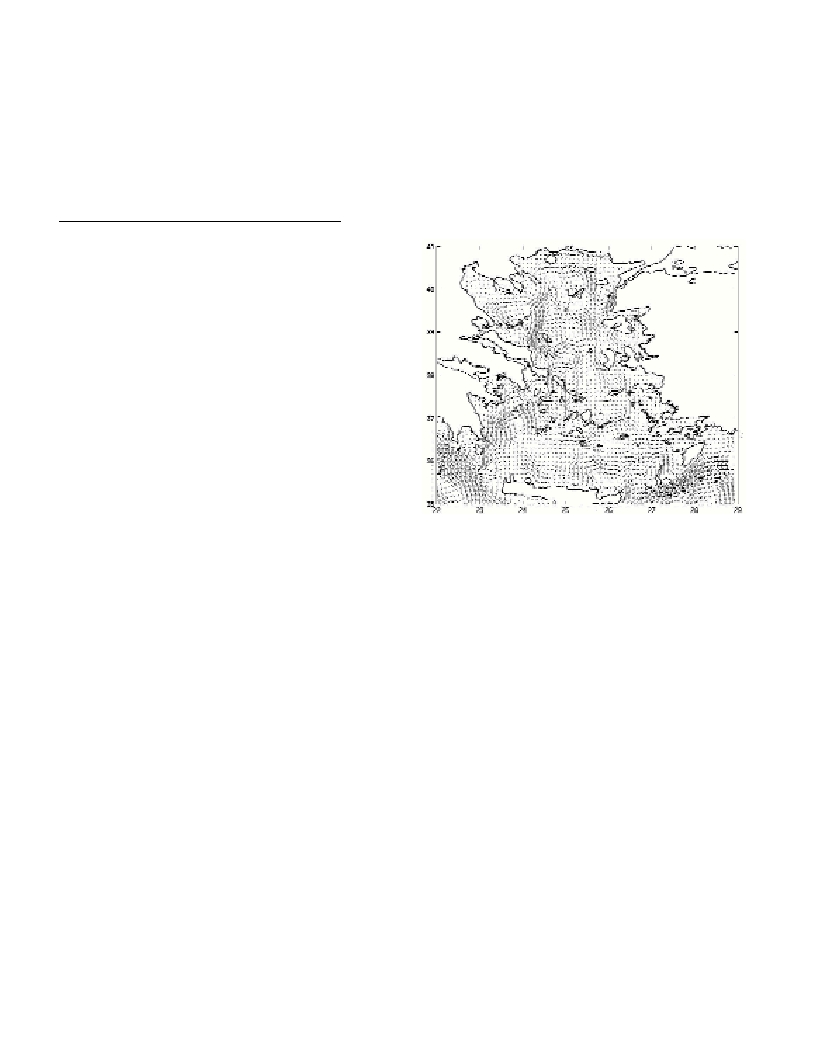Rapp. Comm. int. Mer Médit., 37,2004
143
FORCING MECHANISMS OF THE AEGEAN SEA CIRCULATION
S. Sofianos*, N. Skliris, and A. Lascaratos
Ocean Physics and Modelling Group, University of Athens, University Campus, 15784 Athens, Greece
Abstract
The mechanisms involved in the seasonal patterns of the Aegean Sea circulation are studied with the use of a numerical model (POM). By
performing a series of experiments with different atmospheric forcing and lateral boundary conditions, which are compared with recent
observations in the Aegean Sea, the surface circulation in the basin is being investigated. It is shown that both the seasonal pattern of the
wind field and the seasonal thermohaline forcing are important in producing the observed circulation, while specific features of the
circulation are associated to only one component of the atmospheric forcing.
Key-words: Surface Circulation, Aegean Sea, Modelling
Introduction
Despite the progress in direct observations and modeling efforts
during the last two decades, the circulation of the Aegean Sea is yet
far from being well defined and understood. Recent observations with
Lagrangian drifters [1] emphasized the complex and variable
character of the circulation pattern that can be attributed to the very
irregular topography, the strong seasonality of the atmospheric
forcing, and the presence of many different water masses.
If we attempt to summarize the known circulation characteristics
(from historical data, recent drifter deployment, and modeling
techniques), there seems to be a general cyclonic circulation in the
Aegean Sea. A very important characteristic feature of the circulation
pattern in the basin is the surface in?ow of the brackish Black Sea
Water (BSW) from Dardanelles, which creates a front with the
ambient saltier waters of Levantine origin following the general
cyclonic pattern. However, the most active dynamic features are the
mesoscale cyclonic and anticyclonic eddies and boundary currents
which can extend to several Rossby radii of deformation (around O(10
km)). In this study we aim to identify the mechanisms involved in
basic features and the overall circulation of the Aegean Sea,
performing numerical model experiments.
Method
The numerical experiments were carried out with the Princeton
Ocean Model (POM) [2]. The domain is extended outside the Aegean
Sea, in order to incorporate the effects of the Mediterranean Sea
general circulation. In the first experiment both seasonal wind and
seasonal thermohaline forcing, derived from the ECMWF reanalysis,
are used to drive the model. The BSW in?ow as well as major rivers
runoff is also included in the model configuration. The results are
compared with observations and major features of the surface
circulation have been identified. The next two experiments include
only one driving field, either wind or thermohaline forcing, to
investigate the different role and importance of each one on the
circulation pattern. Finally, the effect of different later boundary
conditions (e.g. no BSW in?ow) is investigated with additional
experiments.
Results and Discussion
The full forcing experiment reproduces the general cyclonic patter
of the surface circulation as well as the most important mesoscale
features (Fig. 1). Although most of them present strong seasonality,
features such as the cyclonic eddies in the Chios basin (central
Aegean), the boundary current along the eastern coast of the Evoia
island, the anticyclonic circulation in the northeastern Aegean, the
Myrtoan Cyclone and the East Cretan Cyclone are robust in the model
results.
The wind- and thermohaline-driven experiments produce results
with comparable surface circulation strength, but in several cases the
circulation patterns are very different. When only the wind forcing
drives the model a strong current following diagonally the central
Aegean is dominating. This is associated with the pattern of the wind-
stress curl field which is negative north of this axis and positive in the
southern part of the basin. This results to a anticyclonic circulation in
the northernmost part of the basin which alters significantly the
circulation pattern and a cyclonic one in the southern part of the basin.
Although features such as the anticyclone in the northeastern Aegean
are intensified, others such as the Evoia Current and the cyclonic
features in the northern Chios basin disappear. Additionally, this
circulation pattern recirculates the brackish BSW in the northern part
of the basin resulting in very low surface salinity while in the same
time the exchange between the north and south Aegean at the eastern
part of the basin is diminished.
Fig. 1. Model derived surface circulation in the Aegean Sea during mid-
July.
The presence of the thermohaline forcing enhances the cyclonic
circulation in the northern Aegean, creating strong density fronts in
the region. All the cyclonic features are present as well as the Evoia
Current. The circulation around the island of Samothrace reverses
most of the year.
The absence of the BSW in?ow results in a considerable decrease
of the surface circulation strength in the northern Aegean as a
consequence of reduced density gradients there. On the other hand,
the circulation in the southern Aegean remains almost unchanged,
suggesting a relative decoupling between the two sub-basins.
References
1-Olson, D. B., 2002. Circulation and mesoscale structure of ?ow in the
Aegean Sea based on pilot drifter study. Aegean Sea Workshop, Rhodes,
8-10 October, 2002.
2-Blumberg, A. F., and G. L. Mellor, 1987. A description of three-
dimensional coastal ocean circulation model. Pp.1-16. In:Heaps N. S.
(ed.), Three-Dimensional Coastal Ocean Circulation Models, Coastal
Estuarine Science, 4, AGU, Washington D.C.

